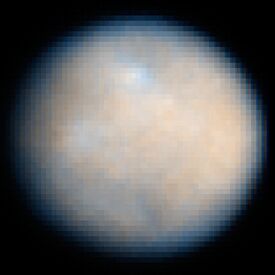 Hubble photo c. 2004 | |
| Discovery | |
|---|---|
| Discovered by: | Giuseppe Piazzi |
| Discovery date: | January 1, 1801 |
| Alternative names: | 1943 XB A899 OF |
| Minor planet category: | Asteroid belt |
| Orbital characteristics | |
| Epoch September 13, 2023 ([JD 2460200.5) [1] | |
| Aphelion distance: | 2.98562 AU |
| Perihelion distance: | 2.76725 AU |
| Semi-major axis: | 2.76725 AU |
| Eccentricity: | 0.0789 |
| Orbital period: | 4.6034 years 1681.4039 days |
| Inclination: | 10.587° |
| Physical characteristics | |
| Dimensions: | 939.4 km |
| Mass: | 9.1×1020 kg[2] |
| Mean density: | 2.162 g/cm3 |
| Rotation period: | 9 hours 4 minutes 27 seconds |
| Albedo: | 0.090 ± 0.03 |
| Absolute magnitude: | 3.34 |
Info[]
Ceres, formal designation 1 Ceres, is the smallest identified dwarf planet in the Solar System and the only one in the asteroid belt. It was discovered on January 1, 1801, by Giuseppe Piazzi, and is named after the Roman goddess Ceres — the goddess of growing plants, the harvest, and motherly love.
It was the first dwarf planet discovered, even though it was only designated that in the 21st century. It was first considered a planet for a few decades after discovery, then demoted to an Asteroid when more were discovered, then was classified a Dwarf Planet in 2006.
With a diameter of 940 km, Ceres is by far the largest and most massive body in the asteroid belt, and contains about a third of the belt's total mass. Recent observations have revealed that it is spherical, unlike the irregular shapes of smaller bodies with lower gravity. The surface of Ceres is probably made of a mixture of water ice and various hydrated minerals like carbonates and clays. Ceres appears to be differentiated into a rocky core and ice mantle. It may harbor an ocean of liquid water underneath its surface, which makes it a potential target in the search for extraterrestrial life.
Ceres' apparent magnitude ranges from 6.7 to 9.3, and even at its brightest is still too dim to be seen with the naked eye, although it is observable with a telescope.
Missions[]
On September 27, 2007, NASA launched the Dawn Space Probe to explore Vesta from 2011–2012 and Ceres since 2015. As of 2024, It is still orbiting around Ceres, but ran out of fuel in November 2018. [3]
The Chinese Space Agency is designing a sample-return mission from Ceres that would take place at some point in the 2020s. [4]